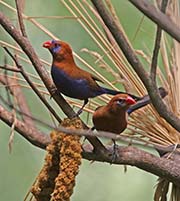Purple Grenadier - Uraeginthus ianthinogaste
| Length | |
| Weight | |
| Clutch Size | |
| Chicks at birth | |
| IUCN Conservation Status | |
Continents: |
The Purple Grenadier is found throughout east Africa. They are sexually dimorphic (the male and female look different). Both sexes have a black tail, a red bill, gray colored feet and legs, and an orange ring around the eye. The male's plumage is a combination of cinnamon (upperparts) and vibrant blues (underparts and face) feathers. The female body is made up of shades of cinnamon and brown with the brighter cinnamon on the head and breast. White barring and spots are scattered on the undersides and a silver-white rings surrounds each eye. She also has some purple on her tail feathers. Juveniles look more like the females.
Diet: Purple Grenadiers eat small seeds from grasses and small plants. Termites are popular, especially as food for the young chicks.
Courtship: Purple Grenadiers form small flocks. During breeding, they separate off into pairs. Part of the courtship ritual includes the male 'bowing' before the female.
Nesting: The male mostly builds the nest in a low brush or tree. The nest is made of grass stems and other plant material. The female lays 3-5 eggs which are incubated by both parents. The chicks are initially fed termites and green seed. As they mature riper seeds are fed to them.
Habitat and Range: Purple Grenadiers are found throughout eastern Africa. They can be common in certain areas and prefer the highlands. They are not common in the arid desert regions and the coast.
Vocalization: The song (in Kenya) is described as "a high, thin chit-cheet tsereea-ee-ee tsit-tsit, or cheerer cheet tsee-tsee sur-chit."
Plumage/Molt They don't have an alternate or breeding plumage.
Migration: No information found that these birds migrate.
Tongue/feet: Note the small tongue above.
Bibliography:
- http://en.wikipedia.org The Free Encyclopedia, Accessed July, 2012
- http://www.honoluluzoo.org Honolulu Zoo, Accessed July, 2012
- Koepff, Christ and April Romagnano, Ph.D., DVM, The Finch Handbook,Barron's Educational Series, Inc. 2001








